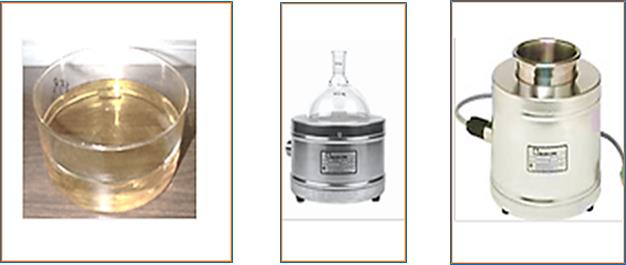Breadcrumb
Oil Baths in Laboratories
Purpose and Applicability
This research safety guidance describes the physical hazards associated with the use of oil baths in research laboratories and measures to take to minimize burns from hot oil and water/hot oil combinations.
Hazards
- Hazards associated with the use of oil baths include hot temperatures and fire.
- Hot oil can cause severe skin burns.
- Accidental additions of water to a hot oil bath can cause serious splattering.
- Mineral oil has an obnoxious smell at the elevated temperatures.
- Reaction flasks immersed in an oil bath can become dangerous slippery.
- Whenever possible, researchers are encouraged to substitute oil baths with a safer alternative such as a sand bath or a heating mantle for solvent reflux/distillation.
Handling
Oil Bath Assembly
Mineral oil or silicone oil is typically used for oil baths in research labs for reactions that require heating/reflux temperatures up to 200 °C. Oil baths provide more uniform heat in comparison to other heating devices. A laboratory oil bath is made of an aluminum or stainless steel pan, a heavy porcelain dish or thick walled Pyrex® glass to withstand breakage and accidental spill.

The electric heating coil (or oil bath on a hot plate) is controlled using a variable voltage controller (i.e., Variac). The voltage controller is adjusted to increase or decrease the temperature setting of the oil bath. Heating mantles should NEVER be plugged directly into an outlet.
Comparison of Heating Assemblies
| Bath Material | Useful Range | Flash Point | Advantage/Disadvantage | Risk |
| Silicone Oil | 25 °C to 230 °C | 150 °C to 350 °C |
| MODERATE |
| Water (rotary evaporator) | 0 °C to 70 °C |
| LOW | |
| Sand | 25°C to 500+ °C | NA |
| LOW |
Personal Protective Equipment (PPE)
- Slip-resistant insulated thermal gloves.
- Safety glasses with side shields or a face shield.
- Lab coat
Appropriate clothing should always be worn in the laboratory which includes closed-toe shoes and long pants/skirt.
Prudent Safety Practices
- Do not place a flat-bottom Pyrex glass oil bath directly on a stirring/hot plate, as this is a fire hazard. Oil baths prepared with Pyrex glass should be placed within a metal secondary container to prevent the glass from breaking and spilling the hot oil.
- The desired oil temperature MUST BE lower than the flash point of the oil. Avoid overheating the oil bath. Smoke indicates that the current temperature is above the safe operating range and smoking oil is highly susceptible to ignition. Do not exceed the recommended temperature limits of the oil. Discard oil that was overheated or appears dark brown in color.
- The oil bath must be monitored using a thermometer. For unattended reactions, oil baths should be fitted with a temperature monitoring device and timer/automatic shut off for the heating operation. This must be set to maintain the heat well below the flash point of the oil.
- Do not overfill the oil bath. Safe depth for an oil bath is no more than two-thirds of the container height when the reaction flask is immersed in the oil.
- Use thick–walled, round-bottom flasks in oil baths for reflux or distillation reactions. Clamp the reaction flask at a safe bath height with an adjustable clamp. If the reaction begins to overheat, the bath height can be immediately adjusted and replaced with a cooling bath.
- Make sure to prevent water from leaking into hot oil baths, which can cause the oil to pop and splatter. In the event of fire, do not use water to put it out.
Storage
- Store the oil bath away from heat sources, including hot plates. When not in use, keep the oil bath covered with a metal cover or cover the bath container with aluminum foil, and store at room temperature.
- Before storing, label the bath with the contents of the oil (fluid name) as well as with the safe working temperature range of the fluid.
- Do not store used oil, including oil drained from the vacuum pump, in any open container including plastic buckets, or rectangular sharps or Biohazard containers.
Spill/Exposure Procedures
Spill Cleanup
Granular clay absorbents, universal polypropylene sorbent pads, or other oil-specific absorbent pads can be used for cleanup of small incidental spills of both bath oil and vacuum pump oil. Solid waste from the cleanup can be scooped, bagged, and placed in a metal container or other compatible container. Oil-specific absorbents absorb only oil and not aqueous materials. For questions, contact EHS for proper cleanup and disposal procedures.
Medical Attention and Emergency Treatment
Use cold water and rinse the affected skin immediately for at least for 15 minutes; remove any hot oil residue without rubbing the skin. If the affected area is on the hand, wrap with a clean bandage to prevent further irritation and injury. DO NOT apply any ointments and avoid breaking blisters. Seek medical attention as necessary.
- Report all lab incidents or exposures to the principal investigator or lab supervisor.
- Complete the first report of injury (FROI) online within 24 hours of the incident or as soon as possible.
- Report all near miss accidents/injuries to the principal investigator or supervisor and EHS as soon as possible.
Waste Disposal
- Do not mix the oil with other laboratory-generated hazardous waste.
- Collect the used oil, including vacuum pump oil, in a glass or plastic container for disposal.
- Label the container as “USED OIL”. Used oil labels are available upon request from EHS.
- Keep the container closed except when adding oil.
- Dispose of used oil through EHS by completing the online hazardous waste pickup form.